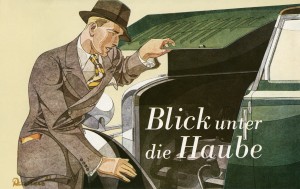
GM re-invested in thoroughly modern and attractive Opel models in the years immediately preceding World War II.
As General Motors moves to sell 55%, and thus majority control, of its principal European division, Opel, to international supplier firm Magna and Russian bank Sberbank, one might observe that Opel is rapidly using up its nine lives.
The German firm started in 1862 as a sewing machine manufacturer. The company subsequently made bicycles, then automobiles; becoming the leading German automaker. Recovering from its defeat in World War I and then runaway inflation in the early 1920s, the German government barred imports of any motor vehicles until 1925. Then it was just one anti-import regulation after another.
General Motors opened a plant in Berlin in this period but found it practical only to build commercial bodies for mounting on Chevrolet truck chassis. So it decided on an end-run around German regulators in Billy Durant fashion by buying into the native industry.
In the spring of 1929, General Motors purchased 80% of Adam Opel AG from the Opel family for just under $26 million (roughly $315 million in today’s dollars, still a bargain). Opel then was market leader in the small German market with an output in 1928 of a mere 43,000 units, tiny by both U. S. and GM standards.
Nevertheless, Opel had a modern manufacturing and assembly facility and provided a window for GM to market not only in Germany, but to German dominated markets in surrounding countries, especially to the East and South. In 1931, GM purchased the balance of Opel stock of an additional $7.4 million.
GM infused Opel with American expertise in mass production, focusing on interchangeable parts. To thwart Germany’s restrictive tariffs, through Opel, GM launched small-bore four- and six-cylinder engines in the early 1930s.
Opel likewise introduced its “Blitz” (Lightning) medium truck line. Opel sales increased from 42,771 in 1928 to 128,370 in 1937 as Germany prospered, ironically, under the Third Reich of Adolf Hitler. Opel’s production of 140,580 in 1938 exceeded that of Oldsmobile and nearly matched that of Buick in the U. S.
However, the Nazis would not let GM or other American companies take any of their profits home. So GM re-invested in thoroughly modern and attractive Opel models in the years immediately preceding World War II, with styling more advanced than on GM’s North American cars.
As World War II got rolling and the Nazi armies overran most of Europe, neither GM’s Opel nor Ford’s Cologne-based Fordwerke made any critical contributions to Germany’s war effort beyond their regular truck lines. Hitler didn’t trust Opel and Fordwerke even after installing Nazi management.
In despair, General Motors wrote off its $35 million investment in Opel in 1943, believing that nothing would be left after Allied bombers pounded Opel plants in Russelsheim and Brandenburg.
After Allied victory in 1945, GM got around to reassessing its European facilities and business. The GM Board traveled to Europe to inspect war damage to all GM’s operations, including Opel, which was rising from the ashes by building Blitz trucks beginning July 15, 1946, and Opel cars in December 1947.
But there was debate among GM management as to whether the corporation should take back Opel, as urged by American military government authorities. A study group in 1948 recommended resumption of control, but were turned down by the GM financial policy committee.
Fortunately, GM Chairman Alfred P. Sloan Jr. overruled the committee by proposing a two-year probationary period for Opel under GM. The corporation had to pay back Uncle Sam for the tax write-off it had taken only a few years earlier.
From then forward, Opel prospered and gave GM a commanding lead over other American manufacturers on the Continent. Opels were imported for sale through Buick dealers in the Fifties and Sixties, reaching a peak of 93,500 in 1969. Twenty years later, Opel production of 1,332,792 exceeded that of Chevrolet.
In recent years, Opel has been the source of engineering for GM cars assembled in North and South America and the Pacific area as well as in Europe. In the U.S., though, the Opel-designed Cadillac Catera was a notable flop.
